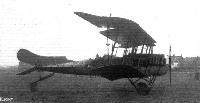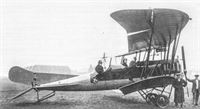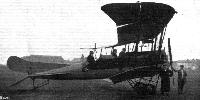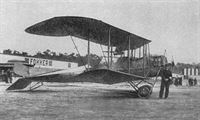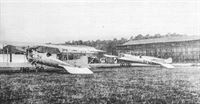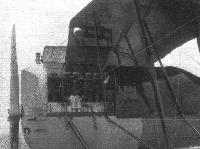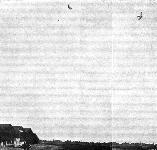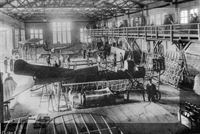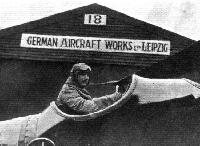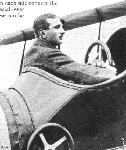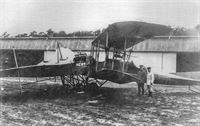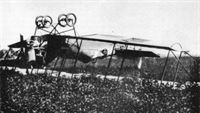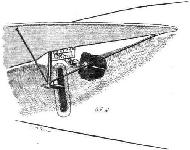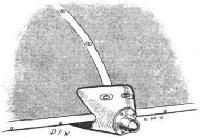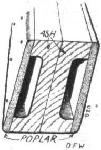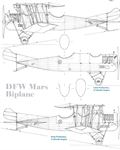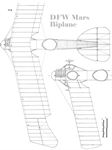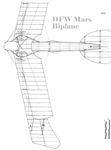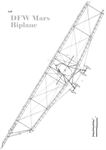
Описание
Страна: Германия
Год: 1912
Варианты
- DFW - Mars - 1912 - Германия
- DFW - Mars biplane - 1912 - Германия
- J.Herris DFW Aircraft of WWI (A Centennial Perspective on Great War Airplanes 29)
- C.Owers Beardmore Aircraft of WW1 (A Centennial Perspective on Great War Airplanes 69)
- Jane's All The World Aircraft 1913
- Журнал Flight
-
J.Herris - DFW Aircraft of WWI /Centennial Perspective/ (29)
DFW Mars Biplane BULLI, DFW Flying School, ca.1914.
-
J.Herris - DFW Aircraft of WWI /Centennial Perspective/ (29)
DFW Mars Biplane DRESDEN, DFW Flying School, before the war.
-
J.Herris - DFW Aircraft of WWI /Centennial Perspective/ (29)
DFW Mars Biplane B.88/13, unit unknown.
-
J.Herris - DFW Aircraft of WWI /Centennial Perspective/ (29)
DFW Mars Biplane with long fin.
-
Журнал - Flight за 1912 г.
The Mars biplane, the fuselage and landing chassis of which are exactly similar to that of the Mars monoplane.
-
Журнал - Flight за 1913 г.
A plan view of the D.F.W, biplane now at Brooklands.
The swept-back wings led to the smaller, more compact DFW Pfeil (Arrow) biplane. -
Журнал - Flight за 1913 г.
THE D.F.W. BIPLANE AT BROOKLANDS. - Side view.
-
J.Herris - DFW Aircraft of WWI /Centennial Perspective/ (29)
The DFW Mars biplanes were powered by a variety of four and six-cylinder engines such as the 95 hp NAG, etc. This later aircraft has a six-cylinder engine and two men are seated in the observer's cockpit.
-
Журнал - Flight за 1914 г.
The D.F.W. biplane, as seen from the side.
-
J.Herris - DFW Aircraft of WWI /Centennial Perspective/ (29)
An early production four-cylinder DFW Mars biplane photographed before the war in front of the Fokker hangar.
-
J.Herris - DFW Aircraft of WWI /Centennial Perspective/ (29)
Early production DFW Mars Arrow biplanes feature different fin and rudder designs. This aircraft has a four-cylinder engine.
-
J.Herris - Development of German Warplanes in WWI /Centennial Perspective/ (1)
The biplane version of the DFW Mars was one of the primitive, miscellaneous airplanes with which Germany entered the war.
-
M.Dusing - German & Austro-Hungarian Aero Engines of WWI. Vol.3 /Centennial Perspective/ (66)
This early DFW Mars biplane was powered by a 4-cylinder engine, perhaps a NAG F 3 which the Mars was known to use.
Ground crew and spectators surround an early four-cylinder DFW Mars biplane whose name is not quite legible. (Peter M. Bowers Collection/Museum of Flight) -
J.Herris - DFW Aircraft of WWI /Centennial Perspective/ (29)
Ground crew attempt to steady an early DFW Mars biplane before takeoff. The engine has four cylinders. (Peter M. Bowers Collection/Museum of Flight)
-
J.Herris - DFW Aircraft of WWI /Centennial Perspective/ (29)
The DFW Mars biplane used as background in this group photo displays its large wingspan of 18 meters.
-
Журнал - Flight за 1914 г.
The D.F.W. biplane from the front.
-
J.Herris - DFW Aircraft of WWI /Centennial Perspective/ (29)
This DFW Mars biplane is serial B 88/13.
-
J.Herris - DFW Aircraft of WWI /Centennial Perspective/ (29)
DFW Mars monoplane at left and Mars biplane at right. Both types were built in small numbers and used for training and reconnaissance in the opening months of the war. Their fuselage and vertical tails were very similar. (Peter M. Bowers Collection/Museum of Flight)
Другие самолёты на фотографии: DFW Mars - Германия - 1912
-
J.Herris - DFW Aircraft of WWI /Centennial Perspective/ (29)
DFW Mars monoplane at right with "DFW" and Mars biplane at left. Both types were built in small numbers and used for training and reconnaissance in the opening months of the war. Their fuselage and vertical tails were very similar. (Peter M. Grosz Collection/SDTB)
Другие самолёты на фотографии: DFW Mars - Германия - 1912
-
J.Herris - DFW Aircraft of WWI /Centennial Perspective/ (29)
Two DFW Mars biplanes are shown at the DFW flying school. The one in front is named BULLI. Both are carrying an early version of the German national insignia, indicating the photo was taken during the war. (Peter M. Bowers Collection/Museum of Flight)
-
J.Herris - DFW Aircraft of WWI /Centennial Perspective/ (29)
A DFW Mars biplane in training service at Doberitz.
-
J.Herris - DFW Aircraft of WWI /Centennial Perspective/ (29)
View of the DFW Mars biplane DRESDEN at the DFW flying school. This aircraft, powered by a six-cylinder engine, carries no national markings, so the photos were probably taken before the war.
-
J.Herris - DFW Aircraft of WWI /Centennial Perspective/ (29)
This postcard of a DFW Mars biplane claims that it was the first aircraft to bomb Paris under command of Flieger Lt. von Hiddessen.
-
M.Dusing - German Aviation Industry in WWI. Volume 1 /Centennial Perspective/ (84)
DFW Mars biplane. (1913)
-
J.Herris - DFW Aircraft of WWI /Centennial Perspective/ (29)
Early production DFW Mars Arrow biplanes feature different fin and rudder designs. This aircraft has a six-cylinder engine.
-
Журнал - Flight за 1914 г.
THE D.F.W. BIPLANE. - A three-quarter view from the back.
-
J.Herris - DFW Aircraft of WWI /Centennial Perspective/ (29)
A DFW Mars biplane attracts a crowd. This later production aircraft is powered by a six-cylinder engine.
-
J.Herris - DFW Aircraft of WWI /Centennial Perspective/ (29)
This DFW Mars biplane demonstrates its ability to fold its upper wings to fit in a tent in the field. (Peter M. Bowers Collection/Museum of Flight)
-
Журнал - Flight за 1913 г.
Harry Oelerich, chief pilot of the D.F.W. Flying School, after beating the German duration record by 6 hrs. 8 mins. a few weeks back.
-
Журнал - Flight за 1914 г.
The front part of the D.F.W. biplane, showing the engine in place.
Open engine cowling on a DFW Mars aircraft. [1914] -
C.Owers - Beardmore Aircraft of WW1 /Centennial Perspective/ (69)
D.F.W. No. 154 under guard to keep inquisitive youngsters away. Points to note are the D.F.W. logo just behind the guard and the serial application to the rudder. No. 154 was at Brooklands by 17 March 1914. These photographs are of the incident of 31 March, 1914 when Lt C.H. Collet, RMA, attempted to fly from Portsmouth to Wick, but force landed at Jenning's Farm, near Donna Nook, Lincs. The front cockpit appears to have the supplementary fuel tank that was fitted for the attempt.
-
J.Herris - DFW Aircraft of WWI /Centennial Perspective/ (29)
A DFW Mars biplane in flight presents a distinctive profile. The Mars Biplanes used ailerons instead of the wing warping most commonly used by the Mars monoplane.
-
Журнал - Flight за 1914 г.
Some fine speciment of banking on the 100 h.p. D.F.W. all-steel Arrow biplane, when being flown recently by Lieut. C. H. Collet, of the Naval Wing of the R.F.C. at Brooklands.
Lieut. Collet, R.N.A.S., who took such a prominent part in the air raid on the Zeppelin sheds on Tuesday, will be remembered as doing some notable flying at Brooklands. Above we give a couple of photographs showing him banking steeply on the D.F.W. all-steel Arrow biplane. -
J.Herris - DFW Aircraft of WWI /Centennial Perspective/ (29)
General view of one of the three erecting shops of the German Aircraft Works, Ltd. (D.F.W.), at Lindenthal, near Leipzig, Germany.
DFW Mars biplanes under construction; the four-cylinder engines indicate these are early production aircraft. -
Журнал - Flight за 1914 г.
Herr Roempler, the skilful pilot of the D.F.W. aeroplane, now at Brooklands.
-
Журнал - Flight за 1914 г.
Lieut. Collet, of the Naval Wing of the R.F.C., in the pilot's seat of the 100 h.p. D.F.W. Arrow biplane, prior to his testing the machine on a long flight at Brooklands.
-
Журнал - Flight за 1914 г.
Lieut. C. H. Collet, who was to have piloted the British-built Beardmore D.F.W. tractor biplane in the Round Britain Race.
-
J.Herris - DFW Aircraft of WWI /Centennial Perspective/ (29)
In addition to the crashes, there were always taxi accidents, a particular hazard for these early aircraft without brakes. Here a DFW Mars biplane has experienced a close encounter of the worst kind with a Taube.
Другие самолёты на фотографии: DFW Taube - Германия - 1913
-
J.Herris - DFW Aircraft of WWI /Centennial Perspective/ (29)
Crash of a DFW Mars biplane; landing accidents were a common occurrence with early aircraft for a number of reasons, including rough airfields and sudden gusts of wind that could overturn them.
-
Журнал - Flight за 1914 г.
Sketch showing front part of fuselage and landing chassis of the D.F.W. biplane.
-
Журнал - Flight за 1914 г.
THE TAIL PLANES OF THE D.F.W. BlPLANE. - Note the wheel outside fuselage by means of which the angle of incidence of the tall plane may be altered during flight.
-
Журнал - Flight за 1914 г.
Sketch showing how angle of incidence of D.F.W. tail plane is altered.
-
Журнал - Flight за 1914 г.
Universal-joint on end of struts of D.F.W. biplane.
-
Журнал - Flight за 1914 г.
One of the "Domes of Silence" fitted on leading edge of D.F.W. wings to facilitate moving them about inside hangar.
-
Журнал - Flight за 1914 г.
Section of D.F.W. wing spar.
-
Журнал - Flight за 1914 г.
Sketch showing how plane struts are hinged in the centre of the D.F.W. biplane.
-
Журнал - Flight за 1914 г.
One side of landing chassis showing mounting of wheels.
-
Журнал - Flight за 1914 г.
The flexible rear portion of the D.F.W. ribs.
-
Журнал - Flight за 1914 г.
THE D.F.W. BIPLANE. - PIan, side and front elevations to scale.
-
J.Herris - DFW Aircraft of WWI /Centennial Perspective/ (29)
DFW Mars biplane
-
J.Herris - DFW Aircraft of WWI /Centennial Perspective/ (29)
DFW Mars biplane
-
J.Herris - DFW Aircraft of WWI /Centennial Perspective/ (29)
DFW Mars biplane
-
J.Herris - DFW Aircraft of WWI /Centennial Perspective/ (29)
DFW Mars biplane
-
C.Owers - Beardmore Aircraft of WW1 /Centennial Perspective/ (69)
D.F.W "Mars" biplane
-
C.Owers - Beardmore Aircraft of WW1 /Centennial Perspective/ (69)
D.F.W "Mars" biplane
J.Herris DFW Aircraft of WWI (A Centennial Perspective on Great War Airplanes 29)
DFW Mars Two-Seaters
The Mars monoplane was designed and built in 1912, the same year as the Mars-Buchner biplane was built. The standard Mars biplane was developed from the Mars-Buchner biplane with a more robust wing cellule. The Mars monoplane and biplane were similar in appearance other than their wings.
The Mars monoplane originally had a four cylinder engine but most had a six-cylinder, 100 hp Argus, Daimler, or NAG engine. The wings were designed to fold. Most used wing warping for roll control although at least one had a modified wing that featured ailerons.
The Mars biplane also originally used four-cylinder engines like the 95 hp NAG, Daimler G4F, and others. Once more powerful six-cylinder engines became available the later production Mars biplanes used these more powerful engines. The wing cellule was a robust, three-and-a-half bay design that was also designed to fold the wingtips for storage in tents while in the field.
Both the Mars monoplane and biplane were two-seat aircraft that could be used for reconnaissance and training. In 1913 a Mars biplane was flown for the Turkish side in the was against Bulgaria, and a long reconnaissance flight was flown with Captain Kemal Bey, later to become president of Turkey Kemal Attaturk.
Small numbers of the Mars biplane were flown at the front during the early part of the Great War, and it is possible that Mars monoplanes were also used at the front. Certainly both types were used for training before and after the beginning of the war.
DFW Mars Specifications
Monoplane Biplane
Engine 100 hp NAG 100 hp Mercedes D.I
Span, Upper 16.8 m 17.0 m
Wing Area 35 m2 46 m2
Length 9.7 m 9 m
Height - 3.18 m
Empty Weight 560 kg 700 kg
Loaded Weight 820 kg 920 kg
Maximum Speed 120 km/h 100 km/h
Описание:







